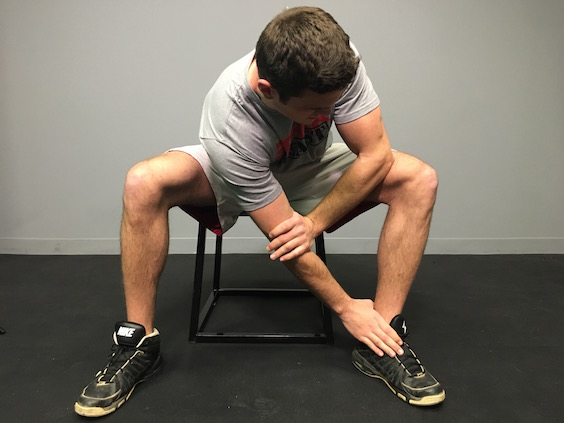Build Explosive Power With This Single-Leg Plyo
![]()
Rear-Foot-Elevated Split Squat Jump. Yes, that’s a mouthful of an exercise name. But don’t let that scare you away. It’s an awesome plyometric exercise that will help you jump higher, sprint faster and change directions quicker in your sport.
It’s based on the Rear-Foot-Elevated Split Squat, arguably one of the most underappreciated and underused exercises for building lower-body strength. Maybe that’s because it’s challenging to perform at first or it doesn’t look nearly as cool as a heavy Back Squat.
Alas.
The Rear-Foot-Elevated Split Squat Jump targets the quads and glutes just like the traditional strength variation. However, the Jump turns it into a plyometric movement that teaches your muscles to absorb force when landing and immediately contract explosively into another jump—the key to developing explosive power.
RELATED: Never Do a Plyometric Cardio Circuit
Why perform this exercise instead of a Squat Jump? In sports, you need to be able to move in every direction. This requires that your left and right legs are equal in terms of strength, power and balance. If one of these qualities is lacking, you might be a step slower in one direction or you may be more susceptible to an injury.
Although the exercise might seem complicated at first glance, it’s easy to perform once you get the hang of it. Mike Boyle, co-founder of Mike Boyle Strength and Conditioning, provides a great demo of the non-jumping version here, which you should learn how to do before trying the jumping variation.
Once you master the technique, you can add the Rear-Foot-Elevated Split Squat Jump to your workouts. Here’s how to do it:
[downloadbutton url=”https://members.stack.com/go/explosive-plyometrics-training-plan/lander” source=”stack” campaign=”plyo-article-promo” medium=”articlebutton” content=”3skill-button-2″ download=”3 Plyo Skills You Must Master” slug=”plyo-3skills-button-2″ /]Step 1: Find a bench or box of equivalent height. Place a pad or towel in front of the bench.
Step 2: Place the top of your left foot flat on the bench and walk forward a few feet to assume a lunge position. The pad should be positioned under your left knee.
Step 3: Keeping your chest up, bend your front knee as if performing a Lunge and lower your left knee straight down until it touches the pad and your front thigh is parallel to the ground. If your torso tilts forward, try shortening your stance. Just make sure your front knee doesn’t travel beyond your toes.
Step 4: Drive off your front heel to jump up as high as possible. Swing your arms to generate momentum.
Step 5: Land softly on your front foot and immediately repeat.
When you’re ready, you can add holding dumbbells.
There are a few different ways you can add this to your workout program.
Perform as a traditional plyo. You can make the Rear-Foot-Elevated Split Squat Jump a traditional plyometric exercise, performing it as a standalone after your warm-up and before strength exercises. Do around 4 sets of 5 reps.
Perform as a complex. One of the great things about this exercise is that you can easily pair the non-jumping and jumping variations. Perform a set of Rear-Foot-Elevated Split Squats, drop the dumbbells and go right into your Jumps. Again, do 4 sets of 5 reps of each exercise.
Try a paused complex. Ben Bruno, a strength coach who works with several pro athletes and celebrities, recently showed off a unique way to perform the exercise. He did a complex like the one above, but with a pause at the bottom of each jumping rep to reset his body position between jumps, which is an easy way to improve the quality of the subsequent jump.
RELATED: 10 Single-Leg Exercises to Build Strength and Eliminate Imbalances
RECOMMENDED FOR YOU
Build Explosive Power With This Single-Leg Plyo
![]()
Rear-Foot-Elevated Split Squat Jump. Yes, that’s a mouthful of an exercise name. But don’t let that scare you away. It’s an awesome plyometric exercise that will help you jump higher, sprint faster and change directions quicker in your sport.
It’s based on the Rear-Foot-Elevated Split Squat, arguably one of the most underappreciated and underused exercises for building lower-body strength. Maybe that’s because it’s challenging to perform at first or it doesn’t look nearly as cool as a heavy Back Squat.
Alas.
[downloadbutton url=”https://members.stack.com/go/explosive-plyometrics-training-plan/lander” source=”stack” campaign=”plyo-article-promo” medium=”articlebutton” content=”3skill-button-1″ download=”3 Plyo Skills You Must Master” slug=”plyo-3skills-button-1″ /]The Rear-Foot-Elevated Split Squat Jump targets the quads and glutes just like the traditional strength variation. However, the Jump turns it into a plyometric movement that teaches your muscles to absorb force when landing and immediately contract explosively into another jump—the key to developing explosive power.
RELATED: Never Do a Plyometric Cardio Circuit
Why perform this exercise instead of a Squat Jump? In sports, you need to be able to move in every direction. This requires that your left and right legs are equal in terms of strength, power and balance. If one of these qualities is lacking, you might be a step slower in one direction or you may be more susceptible to an injury.
Although the exercise might seem complicated at first glance, it’s easy to perform once you get the hang of it. Mike Boyle, co-founder of Mike Boyle Strength and Conditioning, provides a great demo of the non-jumping version here, which you should learn how to do before trying the jumping variation.
Once you master the technique, you can add the Rear-Foot-Elevated Split Squat Jump to your workouts. Here’s how to do it:
[downloadbutton url=”https://members.stack.com/go/explosive-plyometrics-training-plan/lander” source=”stack” campaign=”plyo-article-promo” medium=”articlebutton” content=”3skill-button-2″ download=”3 Plyo Skills You Must Master” slug=”plyo-3skills-button-2″ /]Step 1: Find a bench or box of equivalent height. Place a pad or towel in front of the bench.
Step 2: Place the top of your left foot flat on the bench and walk forward a few feet to assume a lunge position. The pad should be positioned under your left knee.
Step 3: Keeping your chest up, bend your front knee as if performing a Lunge and lower your left knee straight down until it touches the pad and your front thigh is parallel to the ground. If your torso tilts forward, try shortening your stance. Just make sure your front knee doesn’t travel beyond your toes.
Step 4: Drive off your front heel to jump up as high as possible. Swing your arms to generate momentum.
Step 5: Land softly on your front foot and immediately repeat.
When you’re ready, you can add holding dumbbells.
There are a few different ways you can add this to your workout program.
Perform as a traditional plyo. You can make the Rear-Foot-Elevated Split Squat Jump a traditional plyometric exercise, performing it as a standalone after your warm-up and before strength exercises. Do around 4 sets of 5 reps.
Perform as a complex. One of the great things about this exercise is that you can easily pair the non-jumping and jumping variations. Perform a set of Rear-Foot-Elevated Split Squats, drop the dumbbells and go right into your Jumps. Again, do 4 sets of 5 reps of each exercise.
Try a paused complex. Ben Bruno, a strength coach who works with several pro athletes and celebrities, recently showed off a unique way to perform the exercise. He did a complex like the one above, but with a pause at the bottom of each jumping rep to reset his body position between jumps, which is an easy way to improve the quality of the subsequent jump.
RELATED: 10 Single-Leg Exercises to Build Strength and Eliminate Imbalances
[ctaimage group=”3skillsplyo” /]









